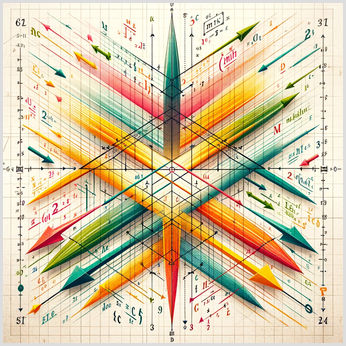Understanding vectors is an important part of mathematics, especially at GCSE. Vectors are entities that have both magnitude and direction. Unlike scalar quantities - which only have magnitude (like temperature or mass) - vectors summarise the idea of moving from one point to another. This idea is fundamental to mathematics and crucial in various fields, including physics, engineering and computer science.
For example, imagine you're walking from one point to another. The direction you take and the distance you cover can be represented as a vector. In maths, this is often shown as an arrow - the length of the arrow indicates the magnitude and the direction describes where the vector points.
At GCSE, the study of vectors opens up a new understanding of mathematics. It's not just about solving equations or crunching numbers; it's about visualising how quantities move and interact in space. This knowledge is not only crucial for excelling in GCSE Maths, but also sets the stage for more advanced studies in A-Level Maths and beyond.
For students looking to delve deeper into the world of vectors and advanced mathematics, finding the right tutor can be a game-changer. If you need further support, consider finding a GCSE Maths tutor to guide you through the complexities of Vectors.
Understanding the basics of the Vector topic
Vectors are fundamental in mathematics, particularly in geometry and physics. At its core, a vector is a quantity defined by both a magnitude (how much) and a direction (which way). This dual nature sets vectors apart from scalar quantities, which only have magnitude.
Key points about vectors:
Magnitude and direction: The magnitude of a vector is a measure of its 'size', often shown by its length in graphical representations. Direction, on the other hand, indicates the vector's orientation in space. For example, a vector representing a 5 km walk east has a magnitude of 5 km and a direction towards the east.
Graphical representation: Vectors are typically illustrated as arrows. The length of the arrow indicates the magnitude and the arrow points in the direction of the vector. This graphical representation is crucial in understanding and solving vector-related problems in mathematics.
Basic vector notation: Vectors are often shown by letters in bold, such as v or u, or with an arrow above. The notation AB represents a vector starting at point A and ending at point B.
Zero vectors and unit vectors: A zero vector has a magnitude of zero and therefore no specific direction. It's represented as 0. A unit vector has a magnitude of one and is often used to indicate direction.
Understanding these basic concepts of vectors lays the groundwork for more complex operations, like addition, subtraction and multiplication by a scalar.
1
Which of the following statements is true about vectors?
Operations with Vectors
Now we understand vectors, it's essential to understand how to perform operations with them. Vector operations are fundamental in many mathematical calculations, especially in physics and engineering.
Vector addition and subtraction: One of the simplest operations with vectors is addition. When you add two vectors, you're essentially putting them end-to-end to find a resultant vector. For example, if you walk 3 km east (vector A) and then 4 km north (vector B), your resultant displacement (vector C) is the vector sum of A and B. Subtracting vectors can be thought of as adding a negative vector. Graphically, these operations can be performed using the 'triangle' or 'parallelogram' method.
Scalar multiplication: Multiplying a vector by a scalar (a regular number) changes its magnitude but not its direction. For instance, if you triple your walking speed, the vector representing your velocity triples in length, but the direction remains unchanged.
These uses aren't just theoretical; they're used to solve real-world problems, such as calculating forces in physics or determining directions in navigation.
2
If vector X represents 5 km east and vector Y represents 3 km north, what is the vector sum of X and Y?
Applications of Vectors in real-world examples
Vectors aren't just abstract concepts; they have numerous practical applications that we need to use in various fields. Understanding how vectors are used in real-life scenarios can help us to understand their importance and functionality. Take a look at the following real-life examples:
Physics: In physics, vectors are crucial in understanding forces and motion. For example, when studying the motion of objects, vectors are used to represent forces, velocity and acceleration, providing direction and magnitude to these quantities. This helps in predicting how objects will move under various forces.
Engineering: Engineers use vectors to design and analyse structures, machinery and systems. In civil engineering, for instance, vectors help in determining the forces acting on bridges or buildings, ensuring their stability and safety.
Navigation: Vectors are indispensable in navigation, both at sea and in the air. They are used to calculate routes, considering direction and speed to determine the most efficient path from one point to another.
Computer graphics: In the realm of computer graphics, vectors play a key role in creating and manipulating images. They are used to model objects and define how they move and interact within a digital space.
Biology: Even in biology, vectors find their application. They can be used to model the spread of diseases or the migration patterns of animals, offering insights into complex biological processes.
These examples of vectors show clearly how mathematical concepts are not confined to textbooks but are essential tools in solving real-world problems.
3
In navigation, if a ship needs to travel 10 km north and 15 km east, how can vectors be used to determine its route?
Advanced Vector concepts
As students progress in their GCSE Maths journey, vectors take on more complex and intriguing forms. Two such advanced concepts are the dot product and the cross product of vectors.
Dot product (Scalar product): The dot product of two vectors is a scalar quantity that is a measure of their 'alignment'. Mathematically, it's calculated as the product of the magnitudes of the two vectors and the cosine of the angle between them. This concept is used in various applications, such as determining the angle between two vectors or finding the projection of one vector onto another.
Cross product (Vector product): In contrast, the cross product of two vectors results in a vector. This new vector is perpendicular to the plane formed by the original vectors and its magnitude is proportional to the area of the parallelogram that the vectors span. The cross product is vital in physics, particularly in calculating torque and angular momentum.
These advanced concepts illustrate the depth and versatility of vector mathematics. For students interested in delving deeper into these topics, we have a range of GCSE Maths tutors who can provide personalised guidance and support in understanding these complex concepts.
4
What does the cross product of two vectors represent?
External resources and further revision
While learning about vectors, it's useful to explore related mathematical concepts that enhance your overall understanding. Here are some recommended resources on topics that supplement the study of vectors:
Physics Classroom - Motion and Forces: Since vectors are widely used in physics, a basic understanding of motion and forces can be helpful. The Physics Classroom provides clear and engaging resources on these topics. Physics Classroom Motion and Forces.
Desmos Graphing Calculator: A powerful tool for graphing vectors and exploring their properties interactively. Desmos can help in visualising vector operations and concepts. Desmos Graphing Calculator.
Wolfram Alpha - Vector Calculations: For advanced students, Wolfram Alpha provides a tool to perform various vector calculations, offering a practical approach to understanding vector operations. Wolfram Alpha Vector Calculator.
These resources provide a well-rounded approach to learning vectors, offering insights into related mathematical and physical concepts. They are ideal for students who wish to broaden their understanding beyond the GCSE curriculum.
Conclusion
As we've explored throughout this article, vectors are a fascinating and integral part of mathematics, with a wide array of applications in various fields. From simple uses like addition and subtraction to more complex concepts like the dot and cross products, vectors provide a fundamental framework for understanding and solving problems in both theoretical and practical contexts.
For GCSE students, mastering vectors is not only crucial for excelling in exams but also lays a solid foundation for future studies in mathematics and sciences. The concepts and skills learned here will be invaluable as you advance to A-Level Maths and beyond.
We hope this article has helped you learn and revise Vectors for GCSE Maths revision, illuminating the world of vectors in a way that is accessible and interesting. Keep exploring, keep learning and most importantly, keep enjoying the journey through the fascinating world of mathematics!
This post was updated on 06 Jul, 2024.

